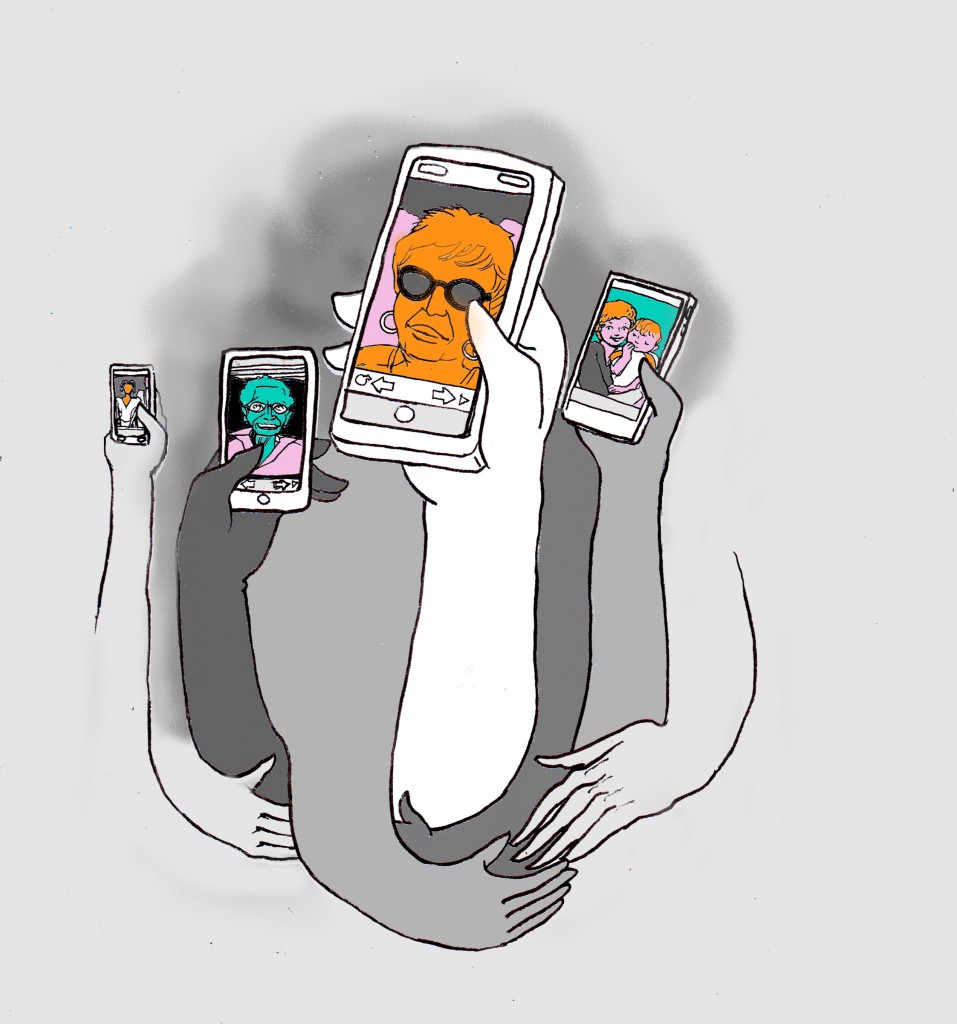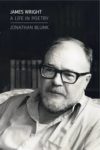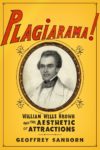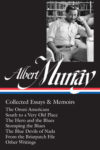
I.
Upon waking at 3:30 AM to catch a flight on a recent Saturday morning, I checked my phone. The iPhone read my thumbprint and recognized my identity. I looked for emails, for Twitter updates, and to access Uber, a car service, to take me to the airport. My phone’s screen showed a number of taxis nearby, and I asked for a driver. One arrived within ten minutes, just after I had hitched my jeans up. My driver, a friendly Moroccan about my own age, left me to wait for my family at the JFK terminal and parted by saying, “I hope you rate me five stars.”
The family — my mother and grandmother — arrived a bit later. The three of us sat eldest to youngest in the plane’s sixteenth row. Granny whispered to me and asked, “Do I look like the wrath of God?” I said she didn’t, gave her a wink, and reached for my earbuds to plug into the in-flight television.
I chose to watch Her, the 2013 film by Spike Jonez about a writer in California whose obsession with his interface software leads to a strange romantic relationship. The software, the company pitches, “is an intuitive identity . . . a consciousness.” Samantha, the interface consciousness, is voiced by Scarlett Johannson. “I’m becoming much more than what they programmed,” she tells the writer.
I looked down the aisles, and saw all of the travelers plugged-in and watching films or television on their touchscreens, too. They were watching “Keeping Up With the Kardashians”, a World Cup match, and SportsCenter. My 85-year-old grandmother had her earbuds in, too, watching the news. I thought of the word digital and how it really means to touch.
II.
We landed safely in San Francisco, metropole of America’s digital world. But for all the hoopla over the Bay Area as a haven for tech companies, no one has addressed the traffic congestion. There are far too many cars in San Francisco. Though our GPS was on, we still managed to get lost before finding, and trudging along, Van Ness Ave, towards the Golden Gate Bridge. From the backseat, my grandmother denounced the gas prices as sinful but then began singing “I Left My Heart in San Francisco”, and when she was done, brought up the murder of Laci Peterson. Before long, she was on to bridge engineering.
“I don’t see what’s so special about this bridge. I much prefer the George Washington.”
And when we passed a fast food joint she said: “In N Out Burger? I see all the stars go there. Speaking of — Clooney finally’s got one with beauty and brains. I’d had enough with all the showgirls George had been chasing.”
Granny talks quite a bit when she’s nervous or excited, or both. Each year my small family visits my grandmother’s eldest sister, Aunt Mim, for her birthday. It’s the only time of the year the two sisters see one another, and so Granny was elated. Aunt Mim turned 95 this year, and just recently moved into an assisted living community in Sonoma, California, fifty miles north of San Francisco. She uses a walker, an instrument she refers to as her boyfriend for all the time she’s spent with it, though she’s not ready to commit to him for the long term, it seems, despite persistent pain in her hip.
“This has been a punk week,” Aunt Mim says by way of a greeting as we enter her abode. “LeBron lost in the Finals.”
During our weekend together I asked Aunt Mim, with what amounted to a journalistic zeal, a series of questions about her life. Aunt Mim spoke into my phone’s recording app, and I captured her voice, tinted with our Southern legacy, to replay and replay, dwelling happily in the ethereal majesty of possessing, and cherishing, her voice and the story of our family.
Aunt Mim and Granny are the granddaughters of Virginian slaves. The stories Granny and her sister share about our family leave me drowning in wonder. Full Stop recently published an essay I wrote that included a couple of stories about their parents. Aunt Mim and Granny were the women who bestowed the stories upon me. But before I could ask Aunt Mim more questions about our family history, my mother asked her about her health.
“How are your teeth?” Mom asked.
“Well, they are mine. I remember when my mother died I was with the mortician, Lenny, a good friend, and he was trying to take mother’s teeth out. I said, ‘Lenny, what on earth? Those are mother’s real teeth!’”
Like her sister, my Granny, Mim’s appearance is fastidious. And male visitors frequent her salon. Manuel, the nurse’s son, is a charming cherub, a four-year-old in Pull-Ups with a disarming smile. He visits her and puts his head, pressed onto his crossed hands like a Raphael angel, right up on her knee.
“Chocolate?” Manuel purrs, breathily, with a hint of his Spanish accent.
“You know where it is,” Aunt Mim responds, and Manuel hightails it to the middle drawer where the Hershey’s Kisses rest.
When we visit, Manuel comes over a few times, but we mostly talk, more or less uninterrupted, for an hour or so. I asked Aunt Mim about passing again, the phenomenon of a light-complexioned black person masquerading as white. Aunt Mim’s mother purposely passed, and ever since I’ve heard that story I’ve been moved by it and have tried to understand it better.
My essay received some attention in the social media forum. It was my first experience I’ve had as a writer where I was able to interact with my readers, and listen to their reactions. I communicated with readers, heard from a couple of editors, caught up with some old friends — and thought incessantly about what others were saying about my family’s story.
III.
Not long ago, The Believer ran an essay by Kate Zambreno about how the author deleted her Twitter account after she recognized her dependency on social media. Zambreno wrote, “I found myself repulsive, caring and craving so much for witness and recognition.”
Managing my social media and communicating over my phone turned out to be an all-day affair on a few occasions in California. It was around-the-clock, and weirdly addictive. In 2010 and 2011 the University of Maryland recruited undergraduates from around the world to stay offline and away from all media for twenty-four hours. When interviewed about their lives without a cellphone the students voiced lamentations. A Chinese student said, “I just like touching my cell phone with my hands, which made me feel full.” An American student said, “I reached into my pocket at least thirty times to pull out a vibrating phone that wasn’t there.” There is something about touching, feeling our phones, that I think contradicts popular sci-fi visions of a future where operating systems exist inside of us. We really like holding onto things, whether it’s a cigarette, a cup of coffee, or a cellphone.
IV.
In Her, the writer has sex with his software. Samantha tells him, “I can feel you inside of me.” He tells her he can feel her, too.
Think for a moment about our interactions with our technology. Petting a phone, pressing it into our ears, putting it along our legs where it vibrates, fetishizing it, lightly toying with an iPhone’s tender button. It is we who are touched by it.
To touch and feel our technology is, essentially, what defines our human condition. “The development of bipedalism created an opportunity for our ancestors’ hands to specialize in feeling and grasping rather than walking,” Professor Alex Soojung-Kim Pang writes. “Evolution selected for hands that had shorter fingers, and nails rather than claws.”
Although we are genetically predisposed to interacting with our tools, every now and then a Sabbath must be observed. To counteract the guilt I felt for checking my phone so often I held Granny’s hand more than I usually do. We walked all over Sonoma like that. And when she was sitting at dinner one night discussing her parents and our family’s legacy, she began crying, and I went over and rubbed her shoulders until she sighed.
Our older Americans are hardly ever touched. My grandfather died nearly 16 years ago. Granny hasn’t been embraced, or loved, nearly enough during that time. Instead of giving my grandmother the kind of attention she deserves, I touch and hold an inanimate object, a phone, and the heavy mental furniture of the social media networks I can access through it obscure my thoughts from what really matters.
V.
The most prescient meditation on social media and technology appeared in book form in the fall of 2013. Dave Eggers’ The Circle is a satiric novel about corporate tech culture set in the Bay Area. The eponym is a megalithic tech firm, Eggers’ fictional world’s most admired company.
Circle’s technology allows humans to “be tracked, cradle to grave, with no possibility of escape.” SECRETS ARE LIES is one of Circle’s Orwellian credos. ALL THAT HAPPENS MUST BE KNOWN is another. In an age when we publicly share a great deal of information, Eggers offers us intriguing, necessary questions to consider regarding all that’s happening on the corporate campuses of Menlo Park and beyond.
Is it that social media affirms our existence? Do we need the approval and recognition of avatars to ease our existential anxieties?
Each of our individual faces, I am told, is the one thing in our lives that we’re never going to see in three-dimensions. Our brains remember things so differently, so much more exactly, when we know an object in three-dimensions. Thus, a patient undergoing facial reconstruction surgery will adjust to her new face in under an hour. A stranger knows your countenance more intimately than you ever can. And so identity can only be crafted amongst others, increasingly done today on the internet.
The success of Circle began with the innovation of a software called TruYou. “TruYou — one account, one identity, one password, one payment system, per person. There were no more passwords, no multiple identities. Your devices knew who you were, and your one identity — the TruYou, unbendable and unmaskable — was the person paying, signing up, responding, viewing and reviewing, seeing and being seen. You had to use your real name, and this was tied to your credit cards, your bank, and thus paying for anything was simple. One button for the rest of your life online . . . The era of false identities, identity theft, multiple user names, complicated passwords and payment systems, was over. Anytime you wanted to see anything, use anything, comment on anything or buy anything, it was one button, one account, everything tied together and trackable and simple, all of it operable via mobile or laptop, tablet or retinal.”
More than just a criticism of our internet hobbies, Eggers’ novel, like Orwell’s 1984, and Jack London’s Iron Heel, asks us to consider how government bodies — political systems ostensibly extant to protect its citizens — engage in domestic surveillance. Eggers channels Aldous Huxley and adds inestimably to this century’s literature. How, Eggers asks, does entanglement with technology affect our individual identities?
VI.
Scholar Henry Louis Gates’ work touches on race-identification and new technologies. “Remember,” Gates’ writes, “while we live in an all-access tracking society of Google Earth and FAA imaging today, our light-complexioned ancestors didn’t. All they needed to be able to pass was a tank of gas and a new destination.”
Today, with the aid of genealogical databases and genetic testing like 23andme, a whole mess of white folks are finding out that they have what Gates’ calls “hidden African ancestry.” Gates asks, “How many ostensibly ‘white’ Americans walking around today would be classified as ‘black’ under the one-drop rule? Judging by the last U.S. Census, 7,872,702. To put that in context, that number is equal to roughly 20 percent, or a fifth, of the total number of people identified as African-American in the same census count!”
Recent reports demonstrate that people with “hidden African ancestry” aren’t the only ones passing. Latinos are increasingly self-identifying as white, too. Is this such a wonder, though, in a country whose history of slavery, and the resultant post-bellum institutionalized prejudice, was the world’s most vicious and violent.
When Aunt Mim describes black people in Jim Crow times, we know they were hardly given recognition, hardly allowed to bear witness to their own lives. As Samuel L. Jackson has said, “People know about the Klan and the overt racism, but the killing of one’s soul, little by little, day after day, is a lot worse than someone coming into your house and lynching you.” Confined to poor and dangerous neighborhoods, overcrowded in classrooms and forced to see films from the balcony in movie theaters — what was called “nigger heaven” — my great-grandmother sought to make her own way, by masquerading, in an unequivocal society. “Sometimes,” Zadie Smith writes, “in a country ripped apart by dogma, those who wish to keep their heads — in both senses — must learn to split themselves in two.”
VII.
In the hills above Sonoma, away from Aunt Mim and Granny who were enjoying the day together, my mother and I spoke about our family at Jack London State Park in Glen Ellen.
Each year we hike in the park and visit the author’s grave, and each year we forget how steep the “moderate” hike is.
As we climb, Mom, a few steps behind and panting, wonders aloud if I brought my rope tow along, and if it wouldn’t kill the park rangers to put in a bench or two? Perhaps a lemonade stand?
We take a break when we reach a swimming hole surrounded by redwoods London dug for the community over a century ago. My mother and I spoke about the factors that affected our family, and millions of other American families, who suffered from racism and prejudices.
“Just as Aunt Mim says,” my mother said, “it’s terrible what racism did to people.”
It’s a notion that had to be inculcated in me. Men and women who passed — and who continue to pass — are victims, not victimizers. They are victims of a society pressuring them into choosing an identity.
My mother, certainly the strongest woman I’ve ever known — a single, never-been-married, breadwinning, Nietzschean uber-woman type — has helped me to see my great-grandmother in another light. Mom said, “She sought more of a life for herself. My grandmother was perhaps the strongest person I know, a feminist before such a word existed, and faced life forward, not looking back.”
With this knowledge in mind, my great-grandmother becomes a kind of trickster — a feminine force on earth years before bras were burnt in Berkeley. She sought freedom during Jim Crow America, a time when, as her contemporary Zora Neale Hurston writes, “de nigger woman is de mule uh de world so fur as ah can see.”
My great-grandmother counterfeited her way to freedom through the forging of an identity. As the celebrated writer and poet Kevin Young remarks, “One crucial aspect of the counterfeit is a renegotiation of borders — and a freedom from an insular identity itself . . . ’Cause, as we all know, the trickster may lie to get over, to save his or her rusty behind, and may leave a few of us tar babies behind in the proverbial briar patch. One of these briar patches may be the link between fiction and fact; another may be between right and white, black and back. Of course, we know freedom ain’t free — one of America’s biggest ironies is that it was only after Emancipation, once black folks had no literal, monetary value to whites, that lynching began. You don’t lynch your mule; you just whip him, or perhaps, if he keeps trying to get loose, you hobble him, or clip the Flying African’s wings. The caged bird sings — or stories — a way out.”
And perhaps I can help story her way out, again; emancipating her from a choice that tore my family in two, but which further blurred the vagaries of race, smudging the color line and allowing her to announce, “I am.”
VIII.
In our hotel on our last night in Sonoma, Granny has her bandana on, Mom is with a book, and I’m thinking about how I’ve got to write this scene down where three generations of my family are sleeping in two beds in a single hotel room. I reached for my phone to take notes. “Bandana”, I typed. “Writing desk full of Granny’s cosmetics. Neatly laid out. Looks like a Bloomingdales counter. Granny’s wig to the right.” If I had tweeted a version of that last sentence, I might have gotten some favorites.
For years I’ve kept notebooks. I still do, though these phones are handy. The issue is that also in my phone is the screen of applications I have. One is an online dating one. I lost a small fraction of my life to that particular app. Seeing the app icon, or just knowing that it’s there, prompts me to remember the dates I’ve had resultant from it, and all of a sudden I’m musing about that time in the Botanical Garden, and not writing at all what I originally set out to do. Perhaps Homer predicted the temptations brought by Tinder and OK Cupid when he urged poets towards celibacy.
But my analog notebook is a kind of technology, too, of course. It is an extension of my mind, my chest of memories. If I were to leaf through it — wasting time, perhaps — I’d come across an entry of a quote from Aunt Mim, a 95-year-old woman, as beautiful as any woman in Sonoma, who weighs less than her age, but who has given me a priceless inheritance of family stories. She said, “Tell that story, baby. That Great American story. Sock it to ‘em, kid.”
Andrew Mitchell Davenport is a middle school teacher, and a writer, in Brooklyn. Andrew can be contacted at [email protected]. Follow him on Twitter @am_davenport.
Madeline Gobbo lives in Brooklyn with her fat cat Louie. See more of her work at madelinegobbo.tumblr.com
This post may contain affiliate links.







